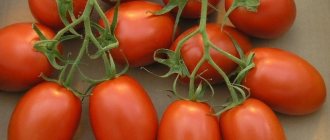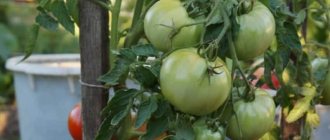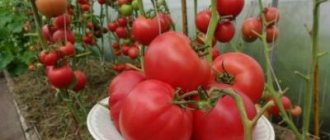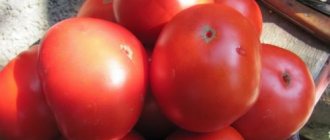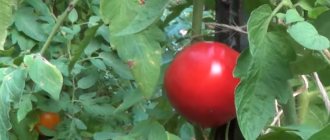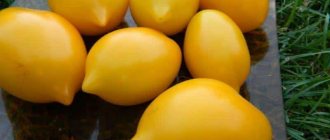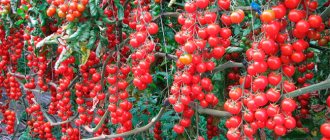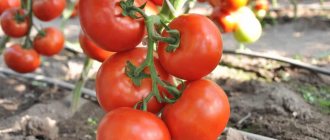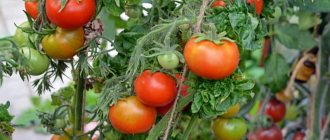Description of the tomato King of the Early
The early King tomato variety has a determinate bush, sometimes called semi-indeterminate. The plant is not very tall at around 70 cm, but strong. With good care, it produces a lot of fruits. The leaves are characteristic green, the flowers are simple. The internodes of the Korol Early variety are not shortened and of normal size.
Advice! Since the Early King tomato is a varietal crop, you can collect seeds for planting next year; they will retain all the characteristics of the parent plant.
The variety is suitable for growing in a greenhouse - the northern and central regions of Russia, and in open ground conditions - Kursk, Astrakhan regions and Krasnodar Territory. The first fruits can be harvested 85-90 days after planting.
Description of fruits
When fully ripe, tomatoes of the Early King variety acquire a red color. The shape of the tomatoes is round, the average weight is 200 g. Inside the fruit there are up to 7 seed chambers, the flesh is fleshy, the presence of dry matter is within 6%. Tomatoes have good keeping quality and are suitable for transportation.
Tomato King of the early ones is shown in the photo:
Video: Proper care of tomatoes
You need to get used to this variety. The first year things didn’t work out for me with him. On the other, I planted one stem, watered and fertilized it thoroughly, and finally got decent fruits, 300 grams each. I picked them first, this is indeed an early variety, ripe tomatoes appeared at the end of July. This is a good indicator for our region, but we also had to close the greenhouse at night, open it during the day, loosen the soil, and water it a little every other day. While you live in the country, you can do this. Make an effort. I liked the bush because it is not tall, very strong, but it needs tying up. The top flowers were removed.
I'm not happy with this variety. This is an early tomato that ripens 2 weeks earlier than the others, but it is very capricious! It needs plenty of nutrition, watering and loosening. It also does not tolerate weather conditions well. It does not tolerate temperature changes and greenhouse heat particularly well. I wanted to get an early harvest, so I planted several bushes in a greenhouse and in open ground under arches. I received the harvest at the same time, no matter whether it was in the greenhouse or in the garden under spunbond, in 95 days. The bush has grown 70 cm, but there are a lot of stepsons! There is also plenty of foliage. I had to cut off the leaves and shoots at least once a week. The bush takes up a lot of space; the greenhouse is already cramped. Planted in a checkerboard pattern at a distance of 70 cm! I tied the bush to pegs to make it easier to care for. Not enough tomatoes were produced. A pair of the largest ones at the bottom and a pair at the top. The flowers were sterilized by the heat and no fruit was produced. In the open ground, the flowers fell off, I still didn’t understand the reason. The care was standard: watering, fertilizing, loosening. I didn’t like the taste of the tomatoes themselves: they were hard, like from a store. The skin is tough, the chambers are large.
I bought my first seeds in a store, and in subsequent years I collected and dried them myself. Those that I collect myself, I usually check for germination by immersing them in salted water. Then I make sure to disinfect them by immersing them in potassium permanganate. After each procedure, the seeds should be thoroughly rinsed with running water. I plant seeds for seedlings in mid-March, when they are a little stronger, I dive into separate pots. I make pots from plastic bottles. In mid-May, I transplant the tomatoes into open ground, but first I harden the seedlings for a week, exposing them to the sun. After disembarking, I constantly monitor the temperature. If frosts are expected, then cover the bed with film - stretch it over the pegs along the edges of the bed. The distance between bushes is 50-70 cm, between rows - 70-80 cm. Bushes should begin to be tied up from the moment they strengthen and grow. The ovary should not lie on the soil - it is affected by slugs. Planting is also required so that the tomatoes do not grow, but begin to ripen. As the tomatoes ripen, you need to pick them - overripe ones crack right on the bushes. Juicy, meaty and tasty - we use this variety both for salads and for preparing juice for the winter.
I have long wanted to plant tomatoes like “King of the Early” on my plot. Because the variety is both large-fruited and early-ripening - a rather rare combination. Summer here in the Volgograd region begins in mid-May and lasts until October, so the climate is favorable. The first ripe tomatoes can be picked already 2.5 months after the seeds germinate, and not after the traditional 3-4. The bushes of this variety are strong, downright stocky, with thick straight stems, so they hardly need support, unless an unimaginable number of fruits are produced. There is no need to worry about pollination and monitor whether there are flying insects on the site or not. Since the flowers are bisexual, they do without outside help in this regard. Tomatoes ripen uneven in size. Those that are tied on the lower branches are huge - 300-400 grams each. Those on the top are never heavier than 100-150 grams. This is not bad - the “top” tomatoes are used whole for wraps, the bottom ones are used for salads, ketchups, and adjika. It is better to plant bushes further away from one another, because if they grow end to end, they may begin to suffer from fungal diseases.
Characteristics of tomato
The characteristics of the Early King tomatoes largely explain their popularity, which continues despite conflicting reviews. This vegetable deserves the attention of gardeners and all the effort spent on growing it.
Productivity and fruiting
The productivity of the Early King tomato variety is quite high: about 5 kg per bush. When planting 3 bushes per 1 sq. m you can collect up to 15 kg of tomatoes. When grown in a greenhouse, the harvest is obtained on the 85th day, and in open ground conditions on the 90–95th day from the date of germination.
Attention! The first fruits of tomatoes of the early King variety can reach a weight of 500 g, then become smaller.
The quantity and quality of fruits is greatly influenced by compliance with agricultural technology. With poor care, there will not be high yields.
Area of application of fruits
The early King tomato variety is universal in use. The pleasant taste of the fruit allows them to be consumed fresh, as well as processed into juices and pastes. Tomatoes are suitable for canning; due to their size, they fit well in jars.
Resistance to diseases and pests
If the early King variety of tomatoes are poorly cared for, they begin to get sick. With timely prevention, this problem can be avoided. The tomato is also attacked by harmful insects: slugs, spider mites, whiteflies, mole crickets.
Advantages and disadvantages of the variety
The main advantages of the Early King tomato variety:
- high productivity;
- early maturation;
- resistance to diseases with proper care;
- good taste;
- versatility in use.
The disadvantages of the variety include:
- decrease in yield after the bush stops growing in height;
- the need to apply large amounts of fertilizer;
- pinching is required so that the bush is not overloaded with fruits;
- It is necessary to prevent diseases and strictly adhere to all rules of agricultural technology.
Description of the variety
The variety is semi-determinant and early ripening. Released in Russia in 2005. The bush is medium-sized, up to 70 cm, with a powerful stem. Suitable for cultivation in greenhouses and open areas. The leaves are rich green, similar to potato leaves. It has simple flowers with 2–3 nests, female and male, that is, it does not require pollination by insects. The plant is branched, with a developed root system.
- Has a number of advantages:
- early maturation;
- productivity;
- dense skin, thanks to which it is well transported and stored;
- easy care;
- universal in use;
- great taste.
Growing rules
The variety is demanding of care, and you will have to work hard to get a large harvest. Therefore, the Early King tomato collects conflicting reviews from those who planted it. Positive feedback is left by gardeners who properly follow all recommendations for growing these tomatoes.
Photo of the early King variety bush:
Planting seedlings
Tomato King early, like most others, require preliminary cultivation of seedlings. Seeds are sown in the second half of March. They are embedded in nutrient soil and left in a warm place.
When tomatoes sprout, they need to be provided with good light. At the same time, in the northern regions special lamps are used. If the seedlings do not receive the required amount of light, they will weaken and stretch out.
When two true leaves appear, the plants dive. You can use peat cups, then you won’t have to plant tomatoes. Seedlings are fed with complex fertilizer twice during the entire growth period before planting. Plants need regular watering and long daylight hours. Before transferring to a greenhouse or open ground, it is recommended to harden young tomatoes.
Tomato transplant
Seedlings are placed in the greenhouse in the second half of April. Plants must be at least 1.5 months old. Young tomatoes are planted in open ground in mid-May. It is possible to move tomatoes in early May, but then you need to use temporary shelter.
Attention! If for some reason the early King tomato plantings are thickened, then they require more abundant feeding, as well as the removal of excess leaves and side shoots.
The Early King tomato will grow and bear fruit well only if it has enough space. An interval of 70 cm is maintained between bushes.
Subsequent care for tomatoes
The Early King tomato is not an unpretentious plant, so it requires certain care measures:
- Despite the fact that the bush is classified as determinant, it will have to be pinched. This happens because the tomato produces many side shoots that create shade and prevent air from entering. In cases where there are too many fruits, entire ovaries are removed, otherwise they will not all be able to ripen.
- It is recommended to remove a few leaves from the bottom of the bush.
- Despite the fact that the stems are quite powerful and low, they need to be tied up so that they do not break from a large number of tomatoes. When they come into contact with the ground, the tomatoes will begin to rot.
- It is important to maintain regular watering, otherwise cracks will form at the stalk. It is better to use drip irrigation.
- Weeding and loosening are mandatory procedures. It is recommended to mulch tomatoes with sawdust or humus.
- This variety needs feeding in large quantities. Mineral complex fertilizers and organic matter are suitable. You cannot use fresh manure or chicken droppings; these fertilizers are allowed only in the form of infusions.
- In extreme heat, tomato bushes growing in open ground need to be shaded.
What is care?
This tomato is not one of those that can grow on its own, like grass along a fence. The king of early ripening tomatoes requires competent and constant care:
- Although the bush belongs to the determinant type, it will still have to be pinched. The fact is that this variety produces a lot of side shoots; if they are not thinned out, the plant will not have enough light and air, and it will inevitably begin to get sick. Shoots and whole ovaries are also removed when there are too many fruits on the bushes - the tomatoes simply cannot ripen in such quantity.
- To prevent tomatoes from getting sick and rotting, it is advisable to tear off a few lower leaves. This is done when the fruits of the lower ovaries are formed.
- You will also have to tie up the bushes, although their height is not too large. The King's shoots are powerful, but they still often cannot support the weight of large fruits. If you do not tie the bush to a support, its branches will lie on the ground and send out roots, which will lead to rotting of both the plant and the fruit.
- Cracks near the stalk (as in the photo) indicate insufficient watering of tomatoes. The king of tomatoes needs a lot of water; this variety responds best to drip irrigation.
- The soil must be loosened and weeds removed. It is recommended to use organic mulch (straw, sawdust, humus).
- The Early King needs to be fed frequently and abundantly, otherwise there will not be a good harvest. You can use any fertilizers: mineral complexes or individual components, any organic matter, except fresh manure and chicken droppings (liquid infusions can be prepared).
- In intense heat, it is advisable to shade the bushes using mesh or special fiber.
Tomatoes need to be picked on time, as the King's fruits are prone to cracking due to overripeness. And it is better to free the bushes from excess weight in a timely manner, then the plant will have enough strength to ripen the next batch of tomatoes.
Pest and disease control
Since tomatoes of the early King variety are susceptible to diseases if not properly cared for, it is important to follow preventive measures: watering regime, weeding, loosening, fertilizing.
The most common diseases to which tomatoes are exposed:
- Late blight. Infected fruits become covered with brown spots, and the leaves have a whitish coating on the reverse side. Three weeks after the seedlings are planted in the ground, treatment with Zaslon is required. After another week, the drug “Barrier” is used. Next, the plantings are sprayed twice a season with Oxychom at intervals of a week. Among the folk remedies against late blight, garlic infusion is used.
- Fusarium. The lower leaves on the bush begin to wither, then all the rest. A pink coating appears on the root collar. Fusarium occurs due to high humidity and excess nitrogen in the soil. The disease is prevented by hilling up bushes and preventive treatment with Barrier and Hom.
- Blackleg. The cause of the disease is frequent watering. It often affects tomato seedlings. The stem at the very bottom turns black, and small spots form on the leaves of the plant. Seedlings infected with blackleg usually dry out and die. For prevention, it is necessary to ensure air movement around the tomato bushes and follow the watering regime. A good preventative measure is treatment with a solution of potassium permanganate.
The most common pests of tomatoes:
- Medvedka. A large insect whose body reaches 6 cm in length. Has a brown color. Creates burrows near the surface of the ground, thereby damaging the roots of tomatoes. The plants eventually die. The drug “Thunder”, as well as an infusion of pepper and a solution of vinegar, help in the fight against mole crickets.
- Slugs. They eat the fruits and above-ground parts of the tomato bush, mainly the leaves. Damaged parts begin to rot. Loosening the soil after watering will help prevent slugs. Ground pepper, ash or lime solution are also used.
- Spider mite. A very small pest - can be found on the plant in the form of a dot. They cover the leaves and young shoots with cobwebs, sucking the juice from the plant. Large yellow spots appear on the affected parts. Karbofos or garlic infusion will help against mites.
Advantages and disadvantages
To briefly characterize tomatoes, you can familiarize yourself with the advantages of the variety:
- the short growing season makes it possible to pick fruits from the garden as early as June (or even from May in case of greenhouse cultivation);
- excellent taste does not limit the ways of using the vegetable;
- simple agricultural technology;
- strong plant immunity, the ability to resist infections and viruses;
- thanks to the dense skin, the fruits retain their presentation for a long time, which is valuable for transporting the harvest;
- high yield.
The disadvantages include the need for regular preventive measures against diseases and pests, as well as the systematic introduction of fertilizing necessary for an intensively developing crop. It is impossible to harvest a good harvest on soil poor in nutrients.
Harvest and storage
In July, the fruits are picked as they are fully ripe. It is imperative to visit the garden bed once every three days and pick everything that is ripe, since these fruits take away the strength of the bush, which will slow down the ripening of still green tomatoes. In August, when the nights are cold and there is more precipitation, brown fruits are also removed from the bushes to prevent late blight.
By creating special conditions, the shelf life of tomatoes can be significantly extended. They are sorted by degree of maturity and laid out in rows in boxes. If there are not many fruits, you can wrap each one in soft paper.
Tomatoes of different ripeness are stored at different temperatures:
- green at +10…+12°С;
- brown at +6°C;
- red at +1…+2°С.
The Early King variety certainly deserves its place in the garden. It is also good because you can grow a crop from your own seeds. So easy to care for and versatile to use, it will delight you with its excellent taste and high yield.
Features of cultivation, planting and care
We recommend sowing the seeds of this tomato variety for seedlings 60-65 days before the intended planting in the ground. Picking seedlings - at the stage of 2 true leaves. When transplanting seedlings to a permanent place, 1 sq. m it is recommended to place up to 6 plants.
Further care for tomatoes consists of timely watering, weed removal, fertilizing with complex mineral fertilizer, pinching and preventive measures to protect the crop from diseases and pests.
Formation and care of determinate tomatoes, video
If you grew King of the Early tomatoes, please write how you liked it. What was the yield and taste of the fruit? Does the variety really catch tomato diseases easily? Will you grow it again? Briefly describe the advantages and disadvantages of this tomato. If possible, attach a photo of the entire bush or individual fruits you grew to your comment. Thank you!
Reviews of the Early King tomato and additions to the description will help many gardeners evaluate this one and decide whether it is worth planting or not.
Sources:
https://agrognom.ru/vegetables/tomatoes/tomat-korol-rannih.html https://otomatah.ru/tomat-korol-rannix.html https://tomatland.ru/catalog/2514
Pros and cons of the variety
The main advantages of the Early King variety include:
- early fruit ripening - about three months from the moment the first shoots appear;
- high productivity;
- large fruit size;
- tomatoes are not prone to cracking;
- good presentation and excellent taste of the collected fruits;
- the harvested crop tolerates transportation well over long distances without losing its taste;
- Ripe fruits have good keeping quality.
The variety has few disadvantages:
- after the bushes stop growing in height, the yield decreases sharply;
- For normal growth and fruiting, a large number of fertilizing is required;
- to prevent the shoots from being overloaded with ripening fruits, pinching is required;
- it is necessary to regularly carry out preventive measures against diseases and pest attacks.
Diseases
Timely spraying of the area using special products will help the gardener avoid the spread of pests. Some of them are quite easy to prepare at home without much waste. Using a solution based on laundry soap will help save your fruit plot from the attacks of spider mites.
Mulched soil is also a fairly effective helper for gardeners. The use of mulching helps to facilitate the fight against weeds and protects crops from attack by slugs. This technique also allows the gardener to protect the soil from drying out and retain moisture more effectively.
As already mentioned, the bushes of this varietal variety of tomatoes are low-growing. However, when the first bunches of fruit ripen, it is worth tying up the bushes. The first fruits in the harvest are always larger than the subsequent ones. Their significant mass can lead to stem breakage. To prevent this unpleasant event, it is strongly recommended to tie up the bushes.
Data
Designed for open planting in the Astrakhan, Kursk regions, and Krasnodar Territory. The regions of the far north are not suitable for this variety, but as a result of selection, the Siberian climate has become native to it.
The variety is able to withstand short-term frosts. Greenhouse conditions allow for a good harvest.
Among the main features are:
- ripe fruits have a characteristic red color;
- average weight 150 – 200 grams;
- multi-chamber - their number reaches 7;
- has a round shape;
- seed content - up to 5%.
When grown in extreme conditions, it has a peculiar Siberian accent. The fruits can be picked unripe, which will extend the shelf life. Tomatoes ripen well in a cool, dark place.
The largest fruits are harvested 80–90 days after planting. Their weight reaches up to 500 grams. The rest of the harvest is medium-sized fruits. From one bush you can harvest up to 4 - 5 kg of wonderful tomatoes. For 1 sq. m there are usually 3 - 4 bushes. Average yield per 1 sq. m - up to 12 kg.
Taking into account the description of the variety and its characteristics, it is possible to plan fruit processing in advance. A vegetable garden and an orchard can be kept in the same area, but the plants will bear fruit at different times. Garden crops are processed separately as they ripen. The first tomatoes are convenient to use for making fresh salads or juice. The rest of the harvest is suitable for canning.
Transplanting tomatoes into open ground
Early King seedlings are planned to be planted in open ground in May (in the greenhouse the date is shifted to April). In this case, the seedlings must reach the age of 60-65 days. The planting scheme used is standard for determinate type plants. The interval between bushes in a row is 50-70 cm, the row spacing is 0.7-1 m. If this option seems too wasteful to someone, then the location of the holes can be planned at a distance of 45-55 cm with a row spacing of 60 cm, but such a scheme will require more careful care: stepson need to be pruned more often, as well as fertilizing.
